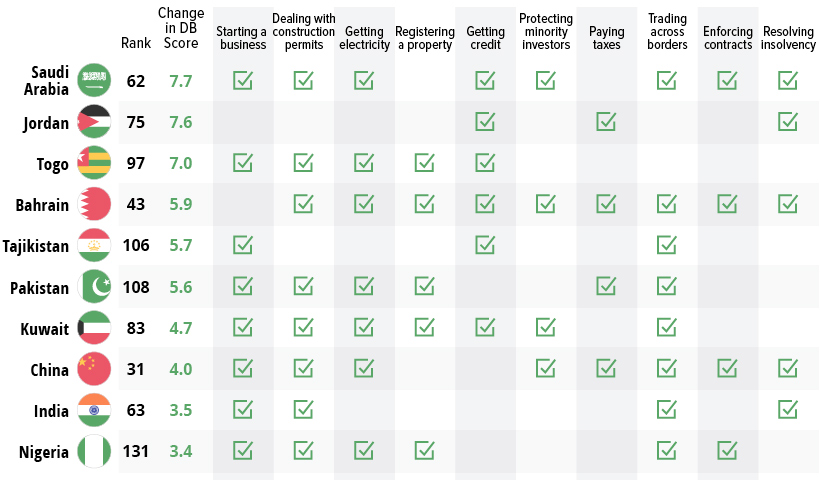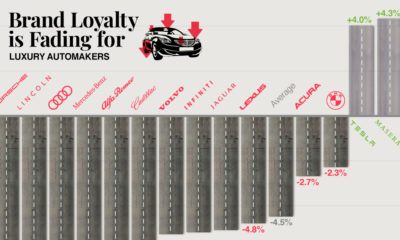Depending on the public policies and application processes of your country, you might struggle or succeed in opening and operating a business. If you live in New Zealand, for example, you can get a new enterprise up and running in half a day. If you live in Luxembourg or Argentina, however, it’s a different story─with the process sometimes taking over a year. Today’s chart uses data from the World Bank’s annual Doing Business 2020 report, which delves into the ease of doing business in countries around the world.
Measuring the Ease of Doing Business
Now in its 17th year, the Doing Business (DB) report measures how easy it is for someone to start and run a company in an economy, using 12 key factors throughout a business lifecycle: Of the 190 countries reviewed last year, only 115 made it easier for entrepreneurs to do business. Note to readers: this year’s DB score did not factor in Employing Workers or Contracting with the Government when ranking economies.
Top 20 Easiest Countries to Run a Business
In the top spot for the fourth year in a row, New Zealand only requires half a day to start a business. Singapore also stands out for having the shortest timeframe when it comes to paying business taxes and enforcing business contracts. Only two African nations─Rwanda and Mauritius─are listed in the top 50 countries, with Mauritius being the only one to crack the top 20 list. Latin American economies are noticeably missing from the rankings, as many countries in this region are fraught with bureaucracy and prolonged processes.
Most Improved Scores
Several developed and developing economies made significant strides in 2019 to implement reforms that opened doors for new business owners. The Doing Business 2020 report shows that the cost of starting a business has fallen over time, particularly in developing economies.
Top 10 Most Improved Economies, 2018-2019
Saudi Arabia made the greatest improvement overall, adding 7.7 points to its score. Bahrain also made improvements over the most number of factors (9). While Jordan showed improvement in the fewest factors (3), it showed the second highest jump in DB Score.
Gains Among Low-Income Countries
The DB 2020 study also shows that developing economies are making progress: it’s now cheaper than ever before to run a business in developing economies. However, a significant disparity still remains when we consider the difference in business costs between high-income and low-income economies. An entrepreneur starting a company in a low-income economy will spend about 50% of per capita income (PCI) to launch a venture, whereas an entrepreneur in a high-income economy spends only 4% PCI to accomplish the same task. Put another way, entrepreneurs located in the bottom 50 economies spend an average six times more to open a new company as those in a high-income economy.
Entrepreneurship and Economic Growth
Generally, more entrepreneurs will enter a market where they can easily conduct business─adding more value to local economies. While the rankings clearly illustrate the link between ease of doing business and economic growth, there are still significant barriers in place that not only deter entrepreneurship but also inhibit a relatively simple strategy for growth. on Today’s chart measures the extent to which 41 major economies are reopening, by plotting two metrics for each country: the mobility rate and the COVID-19 recovery rate: Data for the first measure comes from Google’s COVID-19 Community Mobility Reports, which relies on aggregated, anonymous location history data from individuals. Note that China does not show up in the graphic as the government bans Google services. COVID-19 recovery rates rely on values from CoronaTracker, using aggregated information from multiple global and governmental databases such as WHO and CDC.
Reopening Economies, One Step at a Time
In general, the higher the mobility rate, the more economic activity this signifies. In most cases, mobility rate also correlates with a higher rate of recovered people in the population. Here’s how these countries fare based on the above metrics. Mobility data as of May 21, 2020 (Latest available). COVID-19 case data as of May 29, 2020. In the main scatterplot visualization, we’ve taken things a step further, assigning these countries into four distinct quadrants:
1. High Mobility, High Recovery
High recovery rates are resulting in lifted restrictions for countries in this quadrant, and people are steadily returning to work. New Zealand has earned praise for its early and effective pandemic response, allowing it to curtail the total number of cases. This has resulted in a 98% recovery rate, the highest of all countries. After almost 50 days of lockdown, the government is recommending a flexible four-day work week to boost the economy back up.
2. High Mobility, Low Recovery
Despite low COVID-19 related recoveries, mobility rates of countries in this quadrant remain higher than average. Some countries have loosened lockdown measures, while others did not have strict measures in place to begin with. Brazil is an interesting case study to consider here. After deferring lockdown decisions to state and local levels, the country is now averaging the highest number of daily cases out of any country. On May 28th, for example, the country had 24,151 new cases and 1,067 new deaths.
3. Low Mobility, High Recovery
Countries in this quadrant are playing it safe, and holding off on reopening their economies until the population has fully recovered. Italy, the once-epicenter for the crisis in Europe is understandably wary of cases rising back up to critical levels. As a result, it has opted to keep its activity to a minimum to try and boost the 65% recovery rate, even as it slowly emerges from over 10 weeks of lockdown.
4. Low Mobility, Low Recovery
Last but not least, people in these countries are cautiously remaining indoors as their governments continue to work on crisis response. With a low 0.05% recovery rate, the United Kingdom has no immediate plans to reopen. A two-week lag time in reporting discharged patients from NHS services may also be contributing to this low number. Although new cases are leveling off, the country has the highest coronavirus-caused death toll across Europe. The U.S. also sits in this quadrant with over 1.7 million cases and counting. Recently, some states have opted to ease restrictions on social and business activity, which could potentially result in case numbers climbing back up. Over in Sweden, a controversial herd immunity strategy meant that the country continued business as usual amid the rest of Europe’s heightened regulations. Sweden’s COVID-19 recovery rate sits at only 13.9%, and the country’s -93% mobility rate implies that people have been taking their own precautions.
COVID-19’s Impact on the Future
It’s important to note that a “second wave” of new cases could upend plans to reopen economies. As countries reckon with these competing risks of health and economic activity, there is no clear answer around the right path to take. COVID-19 is a catalyst for an entirely different future, but interestingly, it’s one that has been in the works for a while. —Carmen Reinhart, incoming Chief Economist for the World Bank Will there be any chance of returning to “normal” as we know it?













